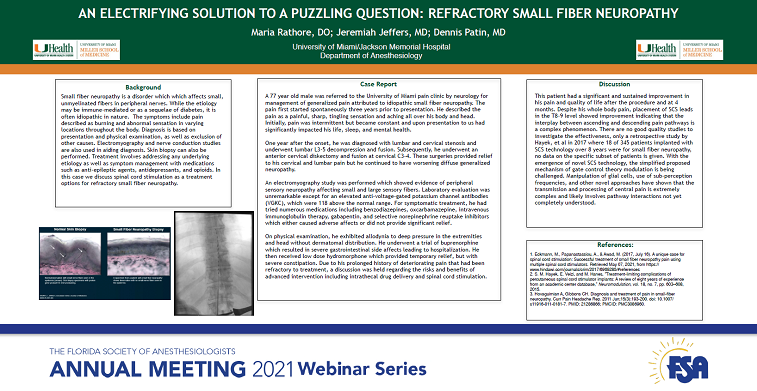2021 FSA Posters
P014: AN ELECTRIFYING SOLUTION TO A PUZZLING QUESTION: REFRACTORY SMALL FIBER NEUROPATHY
Maria Rathore, DO; Jeremiah Jeffers, MD; Dennis Patin, MD; University of Miami
Introduction: Small fiber neuropathy is a disorder which which affects small, unmyelinated fibers in peripheral nerves. While the etiology may be immune-mediated or as a sequelae of diabetes, it is often idiopathic in nature. The symptoms include pain described as burning and abnormal sensation in varying locations throughout the body. Diagnosis is based on presentation and physical examination, as well as exclusion of other causes. Electromyography and nerve conduction studies are also used in aiding diagnosis. Treatment involves addressing any underlying etiology as well as symptom management with medications such as anti-epileptic agents, antidepressants, and opioids. In this case we discuss spinal cord stimulation as atreatment options for refractory small fiber neuropathy.
Case Presentation: A 77 year old male was referred to the University of Miami pain clinic by neurology for management of generalized pain attributed to idiopathic small fiber neuropathy. The pain first started spontaneously three years prior to presentation. He described the pain as a painful, sharp, tingling sensation and aching all over his body and head. Initially, pain was intermittent but became constant and upon presentation to us had significantly impacted his life, sleep, and mental health.
One year after the onset, he was diagnosed with lumbar and cervical stenosis and underwent lumbar L3-5 decompression and fusion. Subsequently, he underwent an anterior cervical diskectomy and fusion at cervical C3-4. These surgeries provided relief to his cervical and lumbar pain but he continued to have worsening diffuse generalized neuropathy.
An electromyography study was performed which showed evidence of peripheral sensory neuropathy affecting small and large sensory fibers. Laboratory evaluation was unremarkable except for an elevated anti-voltage-gated potassium channel antibodies (VGKC), which were 118 above the normal range. For symptomatic treatment, he had tried numerous medications including benzodiazepines, oxcarbamazepine, intravenous immunoglobulin therapy, gabapentin, and selective norepinephrine reuptake inhibitors which either caused adverse affects or did not provide significant relief.
On physical examination, he exhibited allodynia to deep pressure in the extremities and head without dermatomal distribution. He underwent a trial of buprenorphine which resulted in severe gastrointestinal side affects leading to hospitalization. He then received low dose hydromorphone which provided temporary relief, but with severe constipation. Due to his prolonged history of deteriorating pain that had been refractory to treatment, a discussion was held regarding the risks and benefits of advanced intervention including intrathecal drug delivery and spinal cord stimulation.
Discussion: In this case, we discuss the approach to offering advanced interventional pain options to patients suffering from idiopathic or small fiber neuropathy. While spinal cord stimulation and intrathecal drug delivery are well studied in the treatment of established neuropathic pain conditions such as failed back syndrome, chronic regional pain syndrome, or diabetic neuropathy, their use in idiopathic and diffuse pain such as small fiber neuropathy is less clear. This case illustrates one such example of treatment considerations, outcomes, and options for rescue of failed initial treatment in patients with small fiber neuropathy who have failed conservative medical management.

